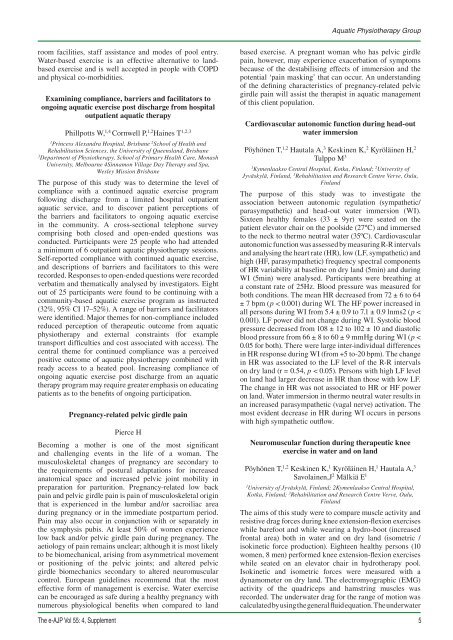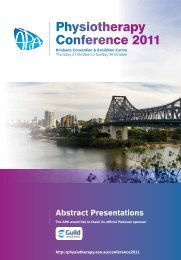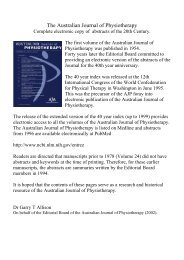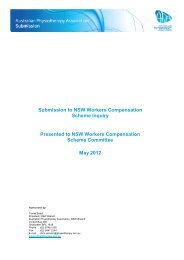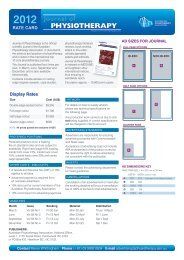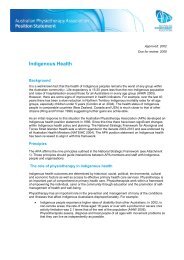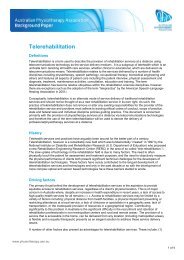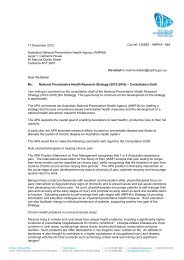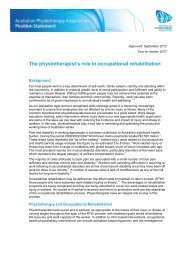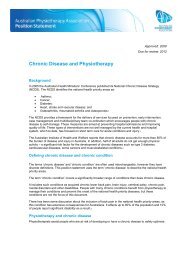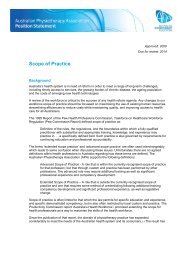2009 APA Conference Week Abstracts - Australian Physiotherapy ...
2009 APA Conference Week Abstracts - Australian Physiotherapy ...
2009 APA Conference Week Abstracts - Australian Physiotherapy ...
Create successful ePaper yourself
Turn your PDF publications into a flip-book with our unique Google optimized e-Paper software.
Aquatic <strong>Physiotherapy</strong> Group<br />
room facilities, staff assistance and modes of pool entry.<br />
Water-based exercise is an effective alternative to landbased<br />
exercise and is well accepted in people with COPD<br />
and physical co-morbidities.<br />
Examining compliance, barriers and facilitators to<br />
ongoing aquatic exercise post discharge from hospital<br />
outpatient aquatic therapy<br />
Phillpotts W, 1,4 Cornwell P, 1,2 Haines T 1,2,3<br />
1<br />
Princess Alexandra Hospital, Brisbane 2 School of Health and<br />
Rehabilitation Sciences, the University of Queensland, Brisbane<br />
3<br />
Department of <strong>Physiotherapy</strong>, School of Primary Health Care, Monash<br />
University, Melbourne 4Sinnamon Village Day Therapy and Spa,<br />
Wesley Mission Brisbane<br />
The purpose of this study was to determine the level of<br />
compliance with a continued aquatic exercise program<br />
following discharge from a limited hospital outpatient<br />
aquatic service, and to discover patient perceptions of<br />
the barriers and facilitators to ongoing aquatic exercise<br />
in the community. A cross-sectional telephone survey<br />
comprising both closed and open-ended questions was<br />
conducted. Participants were 25 people who had attended<br />
a minimum of 6 outpatient aquatic physiotherapy sessions.<br />
Self-reported compliance with continued aquatic exercise,<br />
and descriptions of barriers and facilitators to this were<br />
recorded. Responses to open-ended questions were recorded<br />
verbatim and thematically analysed by investigators. Eight<br />
out of 25 participants were found to be continuing with a<br />
community-based aquatic exercise program as instructed<br />
(32%, 95% CI 17–52%). A range of barriers and facilitators<br />
were identified. Major themes for non-compliance included<br />
reduced perception of therapeutic outcome from aquatic<br />
physiotherapy and external constraints (for example<br />
transport difficulties and cost associated with access). The<br />
central theme for continued compliance was a perceived<br />
positive outcome of aquatic physiotherapy combined with<br />
ready access to a heated pool. Increasing compliance of<br />
ongoing aquatic exercise post discharge from an aquatic<br />
therapy program may require greater emphasis on educating<br />
patients as to the benefits of ongoing participation.<br />
Pregnancy-related pelvic girdle pain<br />
Pierce H<br />
Becoming a mother is one of the most significant<br />
and challenging events in the life of a woman. The<br />
musculoskeletal changes of pregnancy are secondary to<br />
the requirements of postural adaptations for increased<br />
anatomical space and increased pelvic joint mobility in<br />
preparation for parturition. Pregnancy-related low back<br />
pain and pelvic girdle pain is pain of musculoskeletal origin<br />
that is experienced in the lumbar and/or sacroiliac area<br />
during pregnancy or in the immediate postpartum period.<br />
Pain may also occur in conjunction with or separately in<br />
the symphysis pubis. At least 50% of women experience<br />
low back and/or pelvic girdle pain during pregnancy. The<br />
aetiology of pain remains unclear; although it is most likely<br />
to be biomechanical, arising from asymmetrical movement<br />
or positioning of the pelvic joints; and altered pelvic<br />
girdle biomechanics secondary to altered neuromuscular<br />
control. European guidelines recommend that the most<br />
effective form of management is exercise. Water exercise<br />
can be encouraged as safe during a healthy pregnancy with<br />
numerous physiological benefits when compared to land<br />
based exercise. A pregnant woman who has pelvic girdle<br />
pain, however, may experience exacerbation of symptoms<br />
because of the destabilising effects of immersion and the<br />
potential ‘pain masking’ that can occur. An understanding<br />
of the defining characteristics of pregnancy-related pelvic<br />
girdle pain will assist the therapist in aquatic management<br />
of this client population.<br />
Cardiovascular autonomic function during head-out<br />
water immersion<br />
Pöyhönen T, 1,2 Hautala A, 3 Keskinen K, 2 Kyröläinen H, 2<br />
Tulppo M 3<br />
1<br />
Kymenlaakso Central Hospital, Kotka, Finland; 2 University of<br />
Jyväskylä, Finland, 3 Rehabilitation and Research Centre Verve, Oulu,<br />
Finland<br />
The purpose of this study was to investigate the<br />
association between autonomic regulation (sympathetic/<br />
parasympathetic) and head-out water immersion (WI).<br />
Sixteen healthy females (33 ± 9yr) were seated on the<br />
patient elevator chair on the poolside (27ºC) and immersed<br />
to the neck to thermo neutral water (35ºC). Cardiovascular<br />
autonomic function was assessed by measuring R-R intervals<br />
and analysing the heart rate (HR), low (LF, sympathetic) and<br />
high (HF, parasympathetic) frequency spectral components<br />
of HR variability at baseline on dry land (5min) and during<br />
WI (5min) were analysed. Participants were breathing at<br />
a constant rate of 25Hz. Blood pressure was measured for<br />
both conditions. The mean HR decreased from 72 ± 6 to 64<br />
± 7 bpm (p < 0.001) during WI. The HF power increased in<br />
all persons during WI from 5.4 ± 0.9 to 7.1 ± 0.9 lnms2 (p <<br />
0.001). LF power did not change during WI. Systolic blood<br />
pressure decreased from 108 ± 12 to 102 ± 10 and diastolic<br />
blood pressure from 66 ± 8 to 60 ± 9 mmHg during WI (p <<br />
0.05 for both). There were large inter-individual differences<br />
in HR response during WI (from +5 to-20 bpm). The change<br />
in HR was associated to the LF level of the R-R intervals<br />
on dry land (r = 0.54, p < 0.05). Persons with high LF level<br />
on land had larger decrease in HR than those with low LF.<br />
The change in HR was not associated to HR or HF power<br />
on land. Water immersion in thermo neutral water results in<br />
an increased parasympathetic (vagal nerve) activation. The<br />
most evident decrease in HR during WI occurs in persons<br />
with high sympathetic outflow.<br />
Neuromuscular function during therapeutic knee<br />
exercise in water and on land<br />
Pöyhönen T, 1,2 Keskinen K, 1 Kyröläinen H, 1 Hautala A, 3<br />
Savolainen,J 2 Mälkiä E 1<br />
1<br />
University of Jyväskylä, Finland; 2Kymenlaakso Central Hospital,<br />
Kotka, Finland; 3 Rehabilitation and Research Centre Verve, Oulu,<br />
Finland<br />
The aims of this study were to compare muscle activity and<br />
resistive drag forces during knee extension-flexion exercises<br />
while barefoot and while wearing a hydro-boot (increased<br />
frontal area) both in water and on dry land (isometric /<br />
isokinetic force production). Eighteen healthy persons (10<br />
women, 8 men) performed knee extension-flexion exercises<br />
while seated on an elevator chair in hydrotherapy pool.<br />
Isokinetic and isometric forces were measured with a<br />
dynamometer on dry land. The electromyographic (EMG)<br />
activity of the quadriceps and hamstring muscles was<br />
recorded. The underwater drag for the range of motion was<br />
calculated by using the general fluid equation. The underwater<br />
The e-AJP Vol 55: 4, Supplement 5


